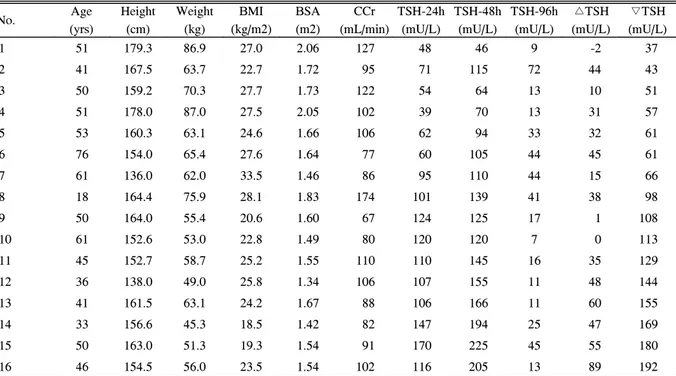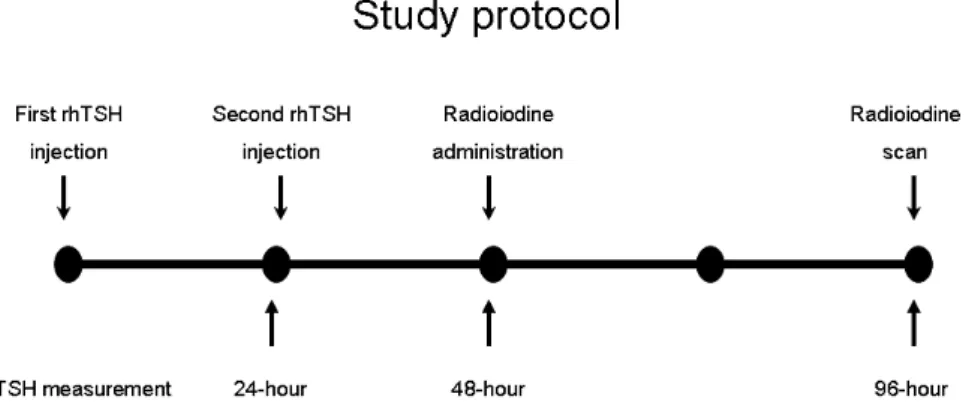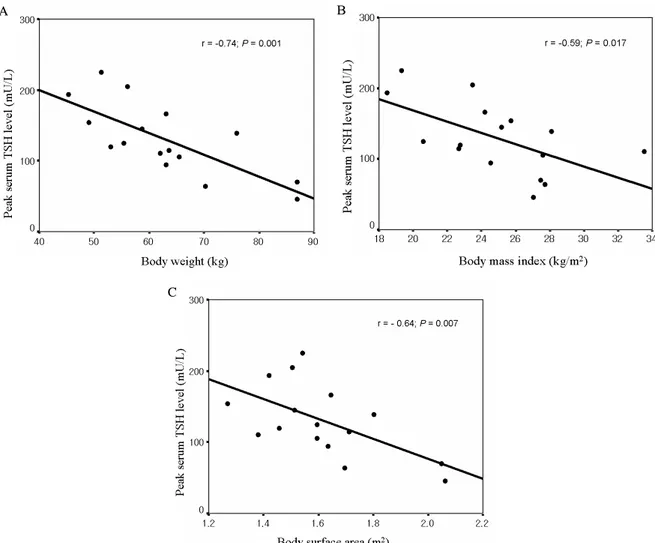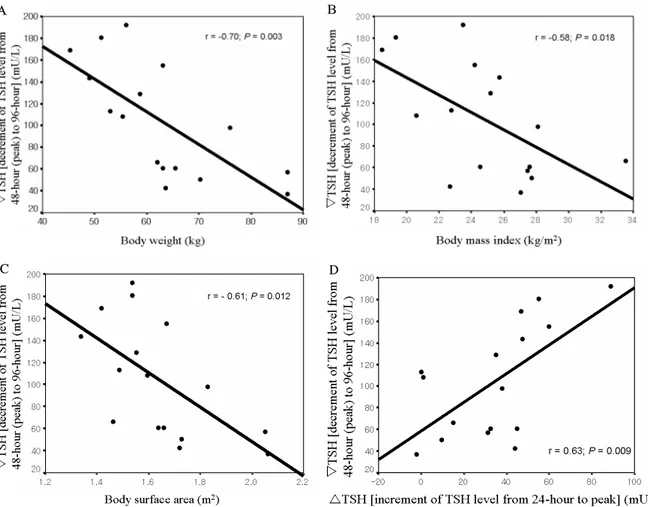1)
접수일자: 2006년 1월 5일 통과일자: 2006년 3월 4일
책임저자: 정재훈, 성균관대학교 의과대학 내분비대사내과
서 론
갑상선 분화암 환자에서 갑상선절제술 후 시행하는 방사 성요오드 투여는 수술 후 남아있는 정상조직 또는 종양을 확인하거나 파괴시킬 목적으로 사용된다. 잔여 갑상선 조직
갑상선 유두암 환자에서 재조합 인간 갑상선자극호르몬(rhTSH)의 약동학 분석
성균관대학교 의과대학 삼성서울병원 내분비-대사 내과
정태식․정혜승․정정화․정윤재․오은영․민용기․이명식․이문규․김광원․정재훈
Analysis of the Pharmacokinetics of Recombinant Human TSH in Patients with Thyroid Papillary Carcinoma
Tae Sik Jung, Hye Seung Jung, Jung Hwa Jung, Yun Jae Chung, Eun Young Oh, Young-Ki Min, Myung-Shik Lee, Moon-Kyu Lee, Kwang-Won Kim, Jae Hoon Chung
Division of Endocrinology and Metabolism, Department of Medicine, Samsung Medical Center, Sungkyunkwan University School of Medicine
ABSTRACT
Background: Individual variations of the pharmacokinetics of recombinant human TSH (rhTSH) might influence the efficacy of the radioactive iodine (RAI) uptake. We studied to investigate the individual pharmacokinetics of rhTSH and the effect of the anthropometric parameters on the serum TSH levels in patients with thyroid papillary carcinoma.
Methods: We selected 16 patients with conventional rhTSH administration for the preparation of RAI administration between June 2004 and May 2005. We measured serum TSH levels at 24-hour (prior to second rhTSH injection), 48-hour (peak level, prior to RAI administration) and 96-hour (prior to scanning) after the first rhTSH injection. We analyzed the correlation of each TSH levels with age, height, weight, creatinine clearance, body mass index (BMI), and body surface area (BSA).
Results: Peak TSH levels were negatively correlated with weight, BMI, and BSA. Among them, weight was an independent parameter by multivariate analysis. Decrement of serum TSH levels from the peak to the level at 96-hour was negatively correlated with weight, BMI, and BSA. It was positively correlated with increment of serum TSH levels from the level at 24-hour to the peak level. Serum TSH level at 96-hour was lower than 25 mU/L in nine of 16 patients.
Conclusion: Body weight was inversely correlated with peak TSH level after rhTSH administration.
rhTSH-stimulated TSH levels might be exaggerated to unwanted levels, and very rapidly degraded in lower-weighted patients. We should make up for the rhTSH regimen considering the individual variations of its pharmacokinetics. (J Kor Soc Endocrinol 21:204~212, 2006)
ꠏꠏꠏꠏꠏꠏꠏꠏꠏꠏꠏꠏꠏꠏꠏꠏꠏꠏꠏꠏꠏꠏꠏꠏꠏꠏꠏꠏꠏꠏꠏꠏꠏꠏꠏꠏꠏꠏꠏꠏꠏꠏꠏꠏꠏꠏꠏꠏꠏꠏꠏꠏꠏꠏꠏꠏꠏꠏꠏꠏꠏꠏꠏꠏꠏꠏꠏꠏꠏꠏꠏꠏꠏꠏꠏꠏꠏꠏꠏꠏꠏꠏꠏꠏꠏꠏꠏꠏꠏꠏꠏꠏꠏꠏꠏꠏꠏꠏ Key Words: Iodine, Pharmacokinetics, Thyrotropin, Thyroid carcinoma, Weight
또는 종양에서 방사성요오드의 섭취를 최대한 증가시키기 위해서 체내 요오드 pool을 감소시키는 것 이외에 혈청 갑 상선자극호르몬(TSH) 농도를 최소 30 mU/L 이상으로 상승 시켜야 한다. 이를 위해서 요오드 제한식사를 일정기간 시행 하면서 복용 중이던 T4 제재를 4~6주간 중단한 후 방사성 요오드를 투여하게 된다. 갑상선절제술 후 4주 이상 갑상선 호르몬 복용을 중단하게 되면 환자는 갑상선기능저하증 상 태가 되어 육체적[1~3] 또는 정신적[3]으로 심한 고통을 받 게 되어 일상생활을 영위하지 못하게 되는 문제점이 발생하 게 된다.
이러한 문제점을 해결하기 위하여 최근 재조합 사람 갑상 선자극호르몬(rhTSH, recombinant human TSH; ThyrogenⓇ, Genzyme, USA)이 개발되었고[4,5], 방사성요오드 스캔의 전처치로 주목을 받고 있다[6~9]. rhTSH는 혈청 TSH 농도 를 빠르게 증가시켜 최고점에 이르게 한 후 다시 빨리 체내 에서 빠져나가는 특징이 있다[2]. rhTSH 0.9 mg을 이틀 연 속 둔부에 근육주사하게 되는데[6], 이 방법은 환자의 임상 적 특성과 개인의 신체적 차이에 관계없이 일률적으로 이루 어지고 있다. 최근에 환자 개인의 신체 표면적이나 제지방체 중(lean body mass)에 따라 rhTSH의 약동학에 차이가 있다 는 보고가 있었다[10,11]. 실제로 임상에서 rhTSH 주사를 한 후 환자마다 혈중 TSH 농도의 변화가 다소 차이가 있음 을 경험하게 된다. 따라서 저자들은 환자의 신체적 차이에 따라 rhTSH의 약동학에 차이가 있고, 이러한 차이는 잔여
갑상선 조직이나 종양의 방사성요오드 섭취에 영향을 미쳐 환자의 평가와 치료의 효율에 영향을 줄 수 있으리라 생각 하였다. 이에 저자들은 rhTSH 주사 후 혈청 TSH 농도 변화 에 영향을 줄 수 있는 신체적 차이를 포함한 임상적 인자를 분석하고, rhTSH의 약동학적 특성에 대하여 평가하여 보고 자 본 연구를 하게 되었다.
대상 및 방법
2004년 6월부터 2005년 5월 사이에 본원에서 rhTSH 주 사로 방사성요오드 투여의 전처치를 한 16명의 환자를 대상 으로 전향적인 연구를 하였다. 대상 환자들은 모두 갑상선 유두암으로 갑상선전절제술을 시행받았다. 대상 환자를 선 정할 때 갑상선암의 병력이외에 다른 질환을 가지고 있는 환자는 제외하였다. 대상 환자들은 갑상선호르몬(T4) 제재, 칼슘, 그리고 비타민 D만을 복용하였고, 그 외의 다른 약은 허용하지 않았다. 환자들은 방사성요오드 스캔 전 시행한 혈 액 검사에서 모두 정상적인 간기능과 신장기능을 보였고, 다 른 혈액검사에서도 특별한 이상은 발견할 수 없었다. 대상 환자들은 모두 여자이었고, 평균 연령은 47.7 ± 13.1 세(18~
76세)이었다. 대상환자들의 평균 신장은 158.9 ± 11.6 cm, 평균 체중은 62.9 ± 12.2 kg, 평균 체질량지수는 24.9 ± 3.8 kg/m2, 크레아티닌 제거율(creatinine clearance)은 101 ± 25
Table 1. Clinical and anthropometric data of 16 patients with thyroid cancer
No. Age
(yrs)
Height (cm)
Weight (kg)
BMI (kg/m2)
BSA (m2)
CCr (mL/min)
TSH-24h (mU/L)
TSH-48h (mU/L)
TSH-96h (mU/L)
△TSH (mU/L)
▽TSH (mU/L)
1 51 179.3 86.9 27.0 2.06 127 48 46 9 -2 37
2 41 167.5 63.7 22.7 1.72 95 71 115 72 44 43
3 50 159.2 70.3 27.7 1.73 122 54 64 13 10 51
4 51 178.0 87.0 27.5 2.05 102 39 70 13 31 57
5 53 160.3 63.1 24.6 1.66 106 62 94 33 32 61
6 76 154.0 65.4 27.6 1.64 77 60 105 44 45 61
7 61 136.0 62.0 33.5 1.46 86 95 110 44 15 66
8 18 164.4 75.9 28.1 1.83 174 101 139 41 38 98
9 50 164.0 55.4 20.6 1.60 67 124 125 17 1 108
10 61 152.6 53.0 22.8 1.49 80 120 120 7 0 113
11 45 152.7 58.7 25.2 1.55 110 110 145 16 35 129
12 36 138.0 49.0 25.8 1.34 106 107 155 11 48 144
13 41 161.5 63.1 24.2 1.67 88 106 166 11 60 155
14 33 156.6 45.3 18.5 1.42 82 147 194 25 47 169
15 50 163.0 51.3 19.3 1.54 91 170 225 45 55 180
16 46 154.5 56.0 23.5 1.54 102 116 205 13 89 192
BMI, body mass index; BSA, body surface area; CCr, creatinine clearance; TSH-24h, TSH-48h, and TSH-96h, serum TSH levels at 24-hour, 48-hour, and 96-hour after first rhTSH injection, respectively; △TSH, increment of TSH level from TSH-24h to TSH-48h (peak level); ▽TSH, decrement of TSH level from TSH-48h to (peak level) TSH-96h.
A B
C
Fig. 2. Changes in serum TSH levels at 24-hour, 48-hour and 96-hour after the first rhTSH administration. A, The changes of serum TSH levels of lower-weighted patients (body weight < 62.9 kg) were rapidly increased to the peak and rapidly cleared out of the body. B, The changes of serum TSH levels in higher-weighted patients (body weight > 62.9 kg) were slowly increased to the peak level and slowly decreased to the basal level. C, The changes of serum TSH levels in all 16 patients.
Among them, serum TSH levels of nine patients were lower than 25 mU/L at 96-hour. This graph was lineated by linking of the four points of serum TSH levels at 0-hour, 24-hour, 48-hour and 96-hour. Therefore, serum TSH levels of this graph at other time might be different from actual serum TSH levels.
Fig. 1. Protocol for this study. Serum TSH was measured for three times, at 24 hours, 48 hours and 96 hours after the first rhTSH injection.
mL/min (67~174 mL/min) 그리고 평균 체표면적은 1.64 ± 0.2 m2이었다(Table 1). rhTSH 0.9 mg을 이틀 연속둔부에 근 육 주사하였고, 첫 번째 rhTSH 주사 후 24시간(2번째 rhTSH 주사 직전), 48시간(방사성요오드 투여 직전), 그리고 96시간 (전신 스캔 촬영 직전)에 각각 혈청 TSH 농도를 3회 측정하 였다(Fig. 1). 16명의 환자들을 평균 체중인 62.9 kg을 기준으 로 각각 8명씩 나누어, 평균 체중보다 높은 군과 낮은 군을 나 누어 rhTSH의 약동학적 변화를 분석하였다(Fig. 2). 혈청 TSH 농도는 면역방사계수측정법(Immunotech, Beckman coulter, Marseille, France)을 이용하여 측정하였다. rhTSH 주사 후 24시간째와 48시간째 최고치 사이의 혈청 TSH 농 도 증가치를 △TSH로, 그리고 rhTSH 주사 후 48시간째 최 고치와 96시간째 농도 사이의 감소치를 ▽TSH로 표시하였 다.
크레아티닌 제거율은 Cockcroft의 방식 [((140-나이(년))
× 체중(kg)/72 × 혈청 크레아티닌(mg/dL)) × 0.85]으로 계 산하였다[12]. 체질량지수는 체중을 신장의 제곱 값으로 나
누었고(kg/m2), 체표면적은 Haycock의 방식 [24.265 × 10-3
× 신장(cm)0.3964 × 체중(kg)0.5378]으로 계산하였다[13]. 혈청 TSH 농도에 영향을 주는 인자의 분석은 Pearson의 단순상 관분석을 이용하였고, 모든 인자들을 전진형 단계별 다중 회 귀 분석을 이용하여 독립적인 인자를 분석하였다. 본 연구에 서는 모든 수치는 평균 표준편차로 표시하였고, P값이 0.05 이하인 경우를 통계적으로 유의하다고 정의하였다.
결 과
첫번째 rhTSH 주사 후 24시간째 평균 혈청 TSH농도는 96.6 ± 37.1 mU/L (39~170 mU/L), 48시간째 평균 최고치 는 129.8 ± 50.8 mU/L (46~225 mU/L) 그리고 96시간째 평균 농도는 25.9 ± 18.6 mU/L (7~72 mU/L)이었다(Fig.
2). rhTSH 주사 후 24시간째와 48시간째 최고치 사이의 혈 청 TSH 농도 증가치(△TSH)는 34.2 ± 24.8 mU/L (-2.2~
A B
C
Fig. 3. Linear regression analysis between serum peak TSH after rhTSH injection and body weight A, body mass index B and body surface area C. The peak serum TSH level was negatively related to body weight (r = -0.74; P = 0.001), BMI (r = -0.59;
P = 0.017) and BSA (r = -0.64; P = 0.007).
89.0 mU/L)이었고, 48시간째 최고치와 96시간째 농도 사이 의 감소치(▽TSH)는 103.9 ± 52.4 mU/L (36.8~192.0 mU/L)이었다. 증례 1의 경우 혈청 TSH 농도는 24시간째에 비하여 48시간째 오히려 감소하였다(48 mU/L → 46 mU/L, Table 1).
혈청 TSH 최고치와 환자의 연령, 신장, 체중, 크레아티닌 제거율, 체질량지수 그리고 체표면적의 상관관계를 Pearson 의 상관분석법에 의하여 분석하였다(Fig. 3). 혈청 TSH 최 고치는 체중(r = -0.74, P = 0.001), 체질량지수(r = -0.59, P
= 0.017) 그리고 체표면적(r = -0.64, P = 0.007)과 역상관 관계이었고, 연령, 신장 그리고 크레아티닌 제거율과는 상관 관계가 없었다. 그러나 다중회귀분석한 결과 상기의 6가지 인자 중 체중만이 유일하게 혈청 TSH 최고치와 역상관 관 계가 있음을 알 수 있었다(standardized β coefficient = -0.741; P = 0.001).
▽TSH는 체중(r = -0.70, P = 0.003), 체질량지수(r = -0.58, P = 0.018) 그리고 체표면적(r = -0.61, P = 0.012)과
는 역상관 관계이었고, 연령, 신장 그리고 크레아티닌 제거 율과는 상관관계가 없었다(Fig. 4). 또한 ▽TSH는 24시간째 의 농도(r = 0.86; P < 0.001), 최고치(r = 0.94; P < 0.001), 그리고 △TSH(r = 0.63; P = 0.009)와 비례관계에 있었고, 96시간째 농도와는 상관관계가 없었다. 그러나 다중회귀분 석에서 ▽TSH는 상기의 6가지 인자들과 상관관계가 없었 다. 96시간째 혈청 TSH 농도는 상기의 6가지 인자들과 유 의한 연관성이 없었고, △TSH와 ▽TSH도 유의한 상관관계 가 없었다.
고 찰
갑상선암에서 방사성요오드 투여의 전처치로 rhTSH 주 사는 진단[6~8]뿐만 아니라 치료의 영역[9]까지 그 사용을 인정받고 있는 추세이다. 그러나 갑상선호르몬을 4~6주간 중단하는 전처치에 비하여 진단과 치료 목적의 전신스캔에
A B
C D
Fig. 4. Linear regression analysis between decrement of serum TSH levels from the peak to the level at 96-hour and body weight (A), body mass index (B), body surface area (C) and increment of serum TSH levels at 24-hour to the peak (D).
Decrement of serum TSH levels from the peak to the level at 96-hour was negatively related with body weight (r = -0.70;
P = 0.003), BMI (r = -0.58; P = 0.018) and BSA (r = -0.61; P = 0.012) and positively related with increment of serum TSH levels from the level at 24-hour to the peak level (r = 0.63; P = 0.009).
서 방사성요오드의 섭취가 상대적으로 떨어진다는 논란이 있다[14~17]. 수술 후 잔여 갑상선 조직이나 종양에서 방사 성요오드의 섭취 정도는 혈청 TSH 농도의 최고치와 유지 기간에 의해 영향을 받는다. rhTSH를 주사하게 되면 혈청 TSH 농도가 빠른 속도로 증가하나, 빠른 속도로 감소되는 특징이 있다. 또한 rhTSH를 주사하게 되면 방사성요오드의 체내 제거가 빠른 속도로 진행되기 때문에 48시간 후의 방 사성요오드의 체내 축적이 갑상선호르몬을 4~6주간 중단하 는 경우의 절반 정도에 해당한다[18].
환자들의 개인적 특성을 고려하지 않고, 일률적으로 모든 환자에게 2회의 rhTSH를 주사하고 있는데, 최근 환자들의 신체계측지수에 따라 혈청 TSH 최고치가 달라진다는 보고 가 있었다[10,11]. Vitale 등[10]은 rhTSH 주사 후 혈청 TSH 의 최고치와 환자의 체중, 체질량지수 그리고 체표면적은 각 각 역상관 관계에 있었고, 연령 및 신장과는 상관관계가 없 었다고 보고하였다. 단순상관관계 분석의 결과는 본 연구결 과와 일치하였다. 그러나 Vitale 등[10]은 다중회귀분석에서 체표면적이 혈청 TSH 최고치에 영향을 미치는 독립적인 인 자라고 하였으나, 본 연구결과에서는 체표면적이 아닌 체중 이 영향을 미치는 독립적인 인자로 분석된 차이점이 있었다.
한편 Castagna 등[11]은 rhTSH가 친수성 약제이므로, 제지 방체중에 의해 영향을 받을 것이라고 주장하였다. 그들은 rhTSH 주사 후 혈청 TSH 최고치와 환자의 신장, 체중, 체질 량지수, 체표면적, 그리고 제지방체중이 역상관 관계에 있다 고 하였고, 그 중에서도 제지방체중만이 독립적인 인자라고 발표하였다. Castagna 등[11]의 연구에서 제지방체중을 구하 기 위하여 환자들을 대상으로 이중에너지 X선흡수계측법 (dual-energy X-ray absorptiometry)을 시행하였는데, 본 연 구결과에 의하면 전체 체중 역시 rhTSH의 약동학적 변화와 연관성이 좋고 간편하며 비용이 적게 드는 방법이라 생각한 다.
증례 1과 증례 4와 같이 체중이 많은 환자들은 일반적으 로 rhTSH 주사 후 혈청 TSH 최고치가 낮은 특성을 나타냈 다. 그러나 체중이 많은 환자들의 혈청 TSH 농도가 최고치 에서 감소되는 정도가 완만한 점으로 보아 체중이 많을수록 TSH의 체내 제거가 느리다는 점을 알 수 있었다. 이에 반하 여 체중이 적은 환자들은 혈청 TSH 농도가 최고치에 급격 하게 상승하였으나 급격하게 감소하는 특징이 있었다(Fig.
2). 일반적으로 방사성요오드 투여 전 혈청 TSH 농도가 최 소 30 mU/L 이상 증가하여야 적절한 검사나 치료가 이루어 진다[19~21]. 본 연구에 참여한 모든 환자가 상기 기준을 통 과하였고, 특히 체중이 60 kg 이하의 환자들의 경우 예외 없 이 혈청 TSH 최고치가 120 mU/L 이상으로 매우 높게 증가 하였다. 일반적으로 실제 혈청 TSH 최고치가 rhTSH 주사 4~6시간 후에 도달함을 고려할 때, 많은 환자들의 혈청 TSH 농도가 과도하게 증가할 것으로 추정한다[2]. 고식적인
rhTSH 방식으로 전처치를 한 후 잔여 종양 또는 전이된 부 위의 갑상선암이 갑자기 팽창되거나 출혈이 발생하였다는 보고가 드물지 않게 있다[22~28]. 이러한 환자들은 전이된 부위의 통증, 호흡장애, 연하장애, 심한 두통 또는 반신불수 등으로 불편을 겪었다고 하였다. 본 연구결과 체중이 적은 환자들 중 일부는 혈청 TSH 농도가 필요 이상으로 과도하 게 증가하여 남아있는 갑상선암 세포를 오히려 자극하지 않 을까 하는 우려를 하게 된다.
rhTSH가 개발된 초기의 연구를 보면 모든 환자에서 첫 번 째 rhTSH 주사 후 96시간째의 혈청 TSH 농도가 25 mU/L 이상이었다고 하였다[6]. 그러나 본 연구에서는 16예 중 9예 (56.3%)의 96시간째 혈청 TSH 농도가 25 mU/L 미만이었다 (Fig. 2). Kogai 등은 FRTL-5 세포에서 TSH 자극에 의하여 유발된 요오드의 축적은 24시간 정도 지연되어 이루어진다고 하였다[29]. TSH에 의한 나트륨-요오드수송기(sodium-iodide symporter) mRNA의 증가는 24시간 정도의 시간이 필요하 고, 단백의 발현은 36시간 이후 증가하기 시작하여 72시간 이 되어야 최고치에 도달한다고 하였다. 본 연구에서 절반이 넘는 환자가 방사성요오드 투여 후 이틀 뒤(첫 번째 rhTSH 주사 후 96시간째) 혈청 TSH농도가 25 mU/L 미만이었는 데, TSH 자극에 의한 요오드의 섭취가 지연됨을 고려할 때 많은 환자들에서 방사성요오드의 섭취가 적절하게 이루어졌 는지 의심스럽다.
최근에 rhTSH 주사에 의한 전처치 방식이 점차 증가하고 있으나, 약이 개발된 초기에 제약회사에서 지원한 연구들을 제외하고는 rhTSH에 대한 약동학 연구는 거의 없었다. 본 연구결과 일률적인 rhTSH 주사 방식은 경우에 따라 혈청 TSH 농도가 과도하게 증가되거나 또는 증가된 TSH 농도의 유지기간이 너무 짧을 수 있다는 문제점을 발견할 수 있었 다. 특히 체중이 적은 환자의 경우 상기의 문제점에 쉽게 노 출될 수 있음을 알 수 있었다. 본 연구결과가 한국인에게 특 이한 약동학 결과인지 또는 다른 인종에게도 공통적인 결과 인지는 더 연구가 진행되어야 알 수 있겠지만, 모든 환자에 게 일률적으로 동일한 용량을 동일한 일정에 의하여 rhTSH 를 주사하던 방식은 최소한 환자의 체중 등의 개인적 특성 을 고려하여 일부 수정 및 보완이 필요할 것으로 생각한다.
결론적으로 본 연구에서 rhTSH 주사 후 혈청 TSH 최고 치와 ▽TSH(최고치에서 감소되는 정도)는 환자의 체중, 체 질량지수 그리고 체표면적과 역상관 관계에 있었으나, 다중 회귀분석에서 체중만이 이에 영향을 미치는 독립적인 인자 이었다. 획일적인 rhTSH 주사방식은 특히 체중이 적은 환자 에서 혈청 TSH 최고치가 너무 과도하게 상승하거나 유지기 간이 짧은 문제점이 발견되었다. 앞으로 더 많은 rhTSH 주 사의 약동학 연구가 축적되어서 이런 약동학적 차이점이 방 사성요오드 스캔의 진단과 치료에 영향을 미치는지에 대한 추가 연구가 필요하리라 생각한다.
요 약
연구배경: rhTSH 주사의 약동학은 환자 개인의 신체적 특성에 따라 차이가 있을 수 있으며, 그 차이가 방사성요오 드 섭취의 효율성에 영향을 줄 수 있을 것이다. 본 연구에서 는 환자 개인별 rhTSH 주사의 약동학에 대해 평가하였고, 혈청 TSH 농도에 영향을 미칠 수 있는 환자의 신체적 특성 을 분석하였다.
방법: 갑상선 유두암으로 갑상선전절제술을 시행받고 방 사성요오드 투여 전처치로 rhTSH 주사를 사용하는 환자 16 예를 대상으로 하였다. 첫번째 rhTSH를 주사하고 24시간, 48 시간 그리고 96 시간째의 혈청 TSH 농도를 측정하였다.
측정된 혈청 TSH 농도와 환자의 연령, 신장, 체중, 크레아 티닌 제거율, 체질량지수 그리고 체표면적과의 연관성에 대 해 분석하였다.
결과: 혈청 TSH 농도 최고치와 환자의 체중, 체질량지수 그리고 체표면적과는 역상관 관계에 있었으나, 다중회귀분 석에 의하여 체중만이 유일한 독립적인 인자이었다. 혈청 TSH 농도가 최고치에서 감소되는 정도(▽TSH) 역시 환자 의 체중, 체질량지수 그리고 체표면적과 역상관 관계에 있었 고, 혈청 TSH 농도가 최고치로 상승되는 정도(△TSH)와 비 례관계에 있었다. 16예 중 9예(56.3%)에서 방사성요오드 스 캔을 촬영하기 직전(첫 번째 rhTSH 주사 후 96시간째)의 혈 청 TSH 농도가 25 mU/L 미만으로 낮게 측정되었다.
결론: rhTSH 주사 후 혈청 TSH 최고치와 체중은 독립적 인 역상관 관계에 있었다. 획일적인 rhTSH 주사 방식은 특 히 체중이적은 환자에서 혈청 TSH 농도를 과도하게 증가시 키거나 또는 증가된 TSH 농도를 유지하는 기간이 짧아지는 문제점이 있음을 발견하였다. 대상 환자의 절반 이상이 방사 성요오드 스캔을 촬영하기 직전의 혈청 TSH 농도가 예상보 다 낮게 나온 문제점도 있었다. 앞으로 더 많은 rhTSH 주사 의 약동학 연구가 축적되어서 이런 약동학적 차이점이 방사 성요오드 스캔의 진단과 치료에 영향을 미치는지에 대한 추 가 연구가 필요하리라 생각한다.
참 고 문 헌
1. Billewicz WZ, Chapman RS, Crooks J, Day ME, Gossage J, Wayne E, Young JA: Statistical methods applied to the diagnosis of hypothyroidism. Q J Med 38:255-266, 1969
2. Meier CA, Braverman LE, Ebner SA, Veronikis I, Daniels GH, Ross DS, Deraska DJ, Davies TF, Valentine M, DeGroot LJ: Diagnostic use of recombinant human thyrotropin in patients with
thyroid carcinoma (phase I/II study). J Clin Endocrinol Metab 78:188-196, 1994
3. Luster M, Felbinger R, Dietlein M, Reiners C:
Thyroid hormone withdrawal in patients with differentiated thyroid carcinoma: a one hundred thirty-patient pilot survey on consequences of hypothyroidism and a pharmacoeconomic comparison to recombinant thyrotropin administration. Thyroid 15:1147-1155, 2005
4. Huber GK, Fong P, Concepcion ES, Davies TF:
Recombinant human thyroid-stimulating hormone:
initial bioactivity assessment using human fetal thyroid cells. J Clin Endocrinol Metab 72:1328-1331, 1991 5. Wondisford FE, Radovick S, Moates JM, Usala SJ,
Weintraub BD: Isolation and characterization of the human thyrotropin beta-subunit gene. Differences in gene structure and promoter function from murine species. J Biol Chem 263:12538-12542, 1988 6. Haugen BR, Pacini F, Reiners C, Schlumberger M,
Ladenson PW, Sherman SI, Cooper DS, Graham KE, Braverman LE, Skarulis MC, Davies TF, DeGroot LJ, Mazzaferri EL, Daniels GH, Ross DS, Luster M, Samuels MH, Becker DV, Maxon HR 3rd, Cavalieri RR, Spencer CA, McEllin K, Weintraub BD, Ridgway EC: A comparison of recombinant human thyrotropin and thyroid hormone withdrawal for the detection of thyroid remnant or cancer. J Clin Endocrinol Metab 84:3877-3885, 1999
7. Moog F, Linke R, Manthey N, Tiling R, Knesewitsch P, Tatsch K, Hahn K: Influence of thyroid-stimulating hormone levels on uptake of FDG in recurrent and metastatic differentiated thyroid carcinoma. J Nucl Med 41:1989-1995, 2000
8. Robbins RJ, Tuttle RM, Sharaf RN, Larson SM, Robbins HK, Ghossein RA, Smith A, Drucker WD:
Preparation by recombinant human thyrotropin or thyroid hormone withdrawal are comparable for the detection of residual differentiated thyroid carcinoma.
J Clin Endocrinol Metab 86:619-625, 2001
9. Barbaro D, Boni G, Meucci G, Simi U, Lapi P, Orsini P, Pasquini C, Piazza F, Caciagli M, Mariani G:
Radioiodine treatment with 30 mCi after recombinant human thyrotropin stimulation in thyroid cancer:
effectiveness for postsurgical remnants ablation and possible role of iodine content in L-thyroxine in the outcome of ablation. J Clin Endocrinol Metab 88:
4110-4115, 2003
10. Vitale G, Lupoli GA, Ciccarelli A, Lucariello A, Fittipaldi MR, Fonderico F, Panico A, Lupoli G:
Influence of body surface area on serum peak thyrotropin (TSH) levels after recombinant human TSH administration. J Clin Endocrinol Metab 88:
1319-1322, 2003
11. Castagna MG, Pinchera A, Marsili A, Giannetti M, Molinaro E, Fierabracci P, Grasso L, Pacini F, Santini F, Elisei R: Influence of human body composition on serum peak thyrotropin (TSH) after recombinant human TSH administration in patients with differentiated thyroid carcinoma. J Clin Endocrinol Metab 90:4047-4050, 2005
12. Cockcroft DW, Gault MH: Prediction of creatinine clearance from serum creatinine. Nephron 16:31-41, 1976
13. Haycock GB, Schwartz GJ, Wisotsky DH: Geometric method for measuring body surface area: a height- weight formula validated in infants, children, and adults. J Pediatr 93:62-66, 1978
14. Ladenson PW, Braverman LE, Mazzaferri EL, Brucker-Davis F, Cooper DS, Garber JR, Wondisford FE, Davies TF, DeGroot LJ, Daniels GH, Ross DS, Weintraub BD: Comparison of administration of recombinant human thyrotropin with withdrawal of thyroid hormone for radioactive iodine scanning in patients with thyroid carcinoma. N Engl J Med 337:
888-896, 1997
15. Pacini F, Molinaro E, Lippi F, Castagna MG, Agate L, Ceccarelli C, Taddei D, Elisei R, Capezzone M, Pinchera A: Prediction of disease status by recombinant human TSH-stimulated serum Tg in the postsurgical follow-up of differentiated thyroid carcinoma. J Clin Endocrinol Metab 86:5686-5690, 2001
16. Pacini F, Molinaro E, Castagna MG, Lippi F, Ceccarelli C, Agate L, Elisei R, Pinchera A: Ablation of thyroid residues with 30 mCi (131)I: a comparison in thyroid cancer patients prepared with recombinant human TSH or thyroid hormone withdrawal. J Clin Endocrinol Metab 87:4063-4068, 2002
17. Mazzaferri EL, Robbins RJ, Spencer CA, Braverman LE, Pacini F, Wartofsky L, Haugen BR, Sherman SI, Cooper DS, Braunstein GD, Lee S, Davies TF, Arafah BM, Ladenson PW, Pinchera A: A consensus report
of the role of serum thyroglobulin as a monitoring method for low-risk patients with papillary thyroid carcinoma. J Clin Endocrinol Metab 88:1433-1441, 2003
18. Park SG, Reynolds JC, Brucker-Davis F, Whately M, McEllin K, Maxted D, Robbins J, Weintraub BD:
Iodine kinetics during 131-I scanning in patients with thyroid cancer: comparison of studies with recombinant human TSH (rhTSH) vs. hypothyroidism. J Nucl Med 37(abstr):15P, 1996
19. Edmonds CJ, Hayes S, Kermode JC, Thompson BD:
Measurement of serum TSH and thyroid hormones in the management of treatment of thyroid carcinoma with radioiodine. Br J Radiol 50:799-807, 1977 20. McDougall IR, Weigel RJ: Recombinant human
thyrotropin in the management of thyroid cancer. Curr Opin Oncol 13:39-43, 2001
21. Kohlfuerst S, Igerc I, Lind P: Recombinant human thyrotropin is helpful in the follow-up and 131I therapy of patients with thyroid cancer: a report of the results and benefits using recombinant human thyrotropin in clinical routine. Thyroid 15:371-376, 2005
22. Vargas GE, UY H, Bazan C, Guise TA, Bruder JM:
Hemiplegia after thyrotropin alfa in a hypothyroid patient with thyroid carcinoma metastatic to the brain.
J Clin Endocrinol Metab 84:3867-3871, 1999 23. Robbins RJ, Voelker E, Wang W, Macapinlac HA,
Larson SM: Compassionate use of recombinant human thyrotropin to facilitate radioiodine therapy: case report and review of literature. Endocr Pract 6:460- 464, 2000
24. Braga M, Ringel MD, Cooper DS: Sudden enlargement of local recurrent thyroid tumor after recombinant human TSH administration. J Clin Endocrinol Metab 86:5148-5151, 2001
25. Lippi F, Capezzone M, Angelini F, Taddei D, Molinaro E, Pinchera A, Pacini F: Radioiodine treatment of metastatic differentiated thyroid cancer in patients on L-thyroxine, using recombinant human TSH. Eur J Endocrinol 144:5-11, 2001
26. Giovanni V, Arianna LG, Antonio C, Francesco F, Michele K, Giovanni S, Marco S, Giovanni L: The use of recombinant human TSH in the follow-up of differentiated thyroid cancer: experience from a large patient cohort in a single centre. Clin Endocrinol
(Oxf) 56:247-252, 2002
27. Goffman T, Ioffe V, Tuttle M, Bowers JT, Mason ME: Near-lethal respiratory failure after recombinant human thyroid-stimulating hormone use in a patient with metastatic thyroid carcinoma. Thyroid 13:827- 830, 2003
28. Chiu AC, Delpassand ES, Sherman SI: Prognosis and
treatment of brain metastases in thyroid carcinoma. J Clin Endocrinol Metab 82:3637-3642, 1997
29. Kogai T, Endo T, Saito T, Miyazaki A, Kawaguchi A, Onaya T: Regulation by thyroid-stimulating hormone of sodium/iodide symporter gene expression and protein levels in FRTL-5 cells. Endocrinology 138:
2227-2232, 1997



